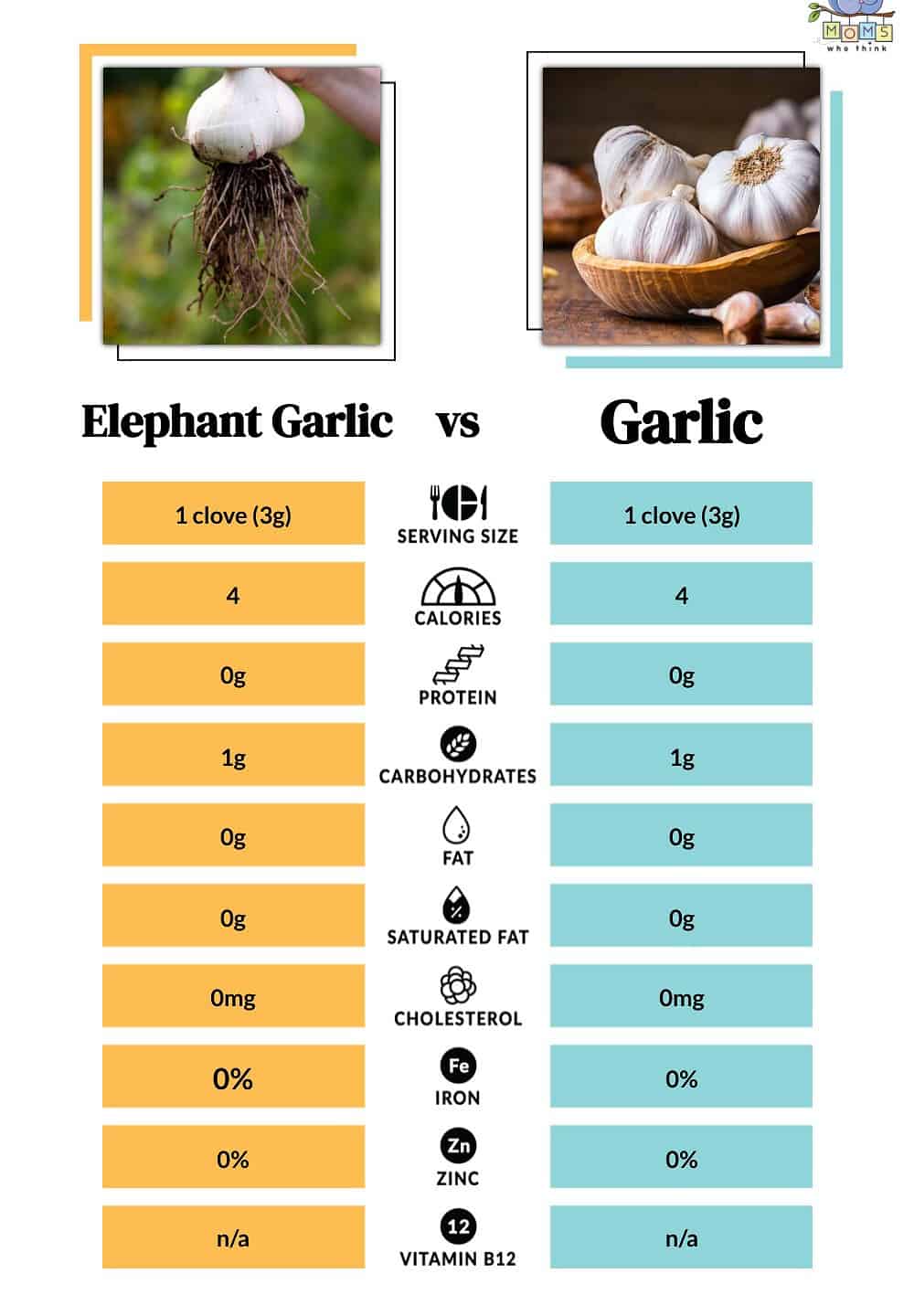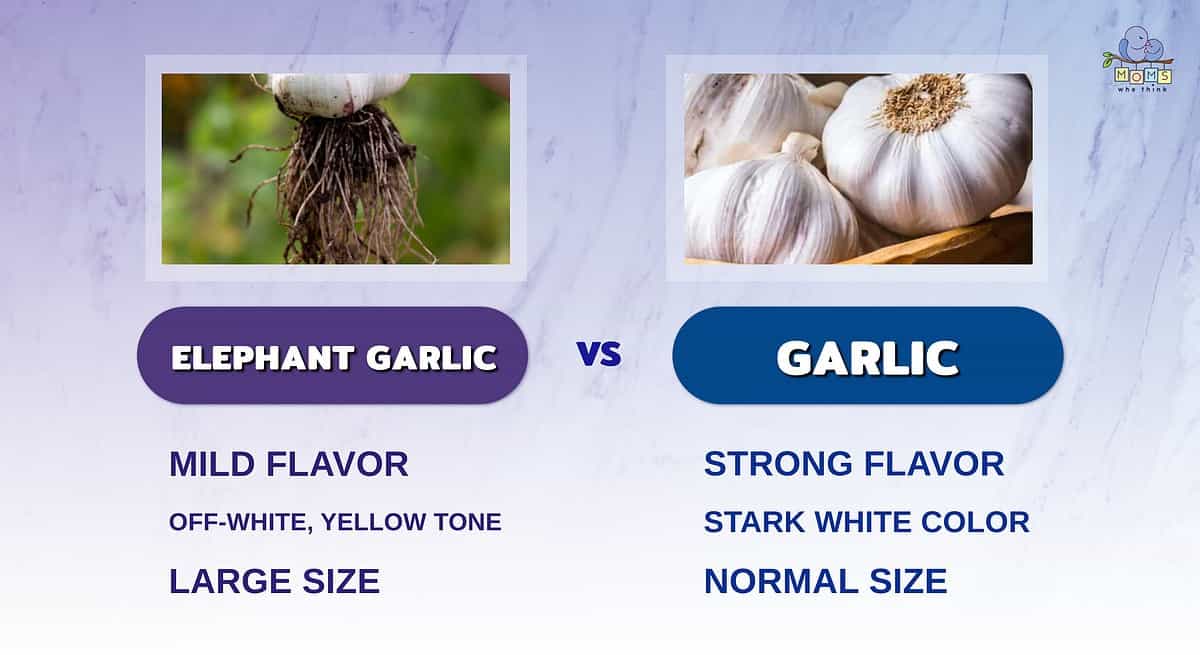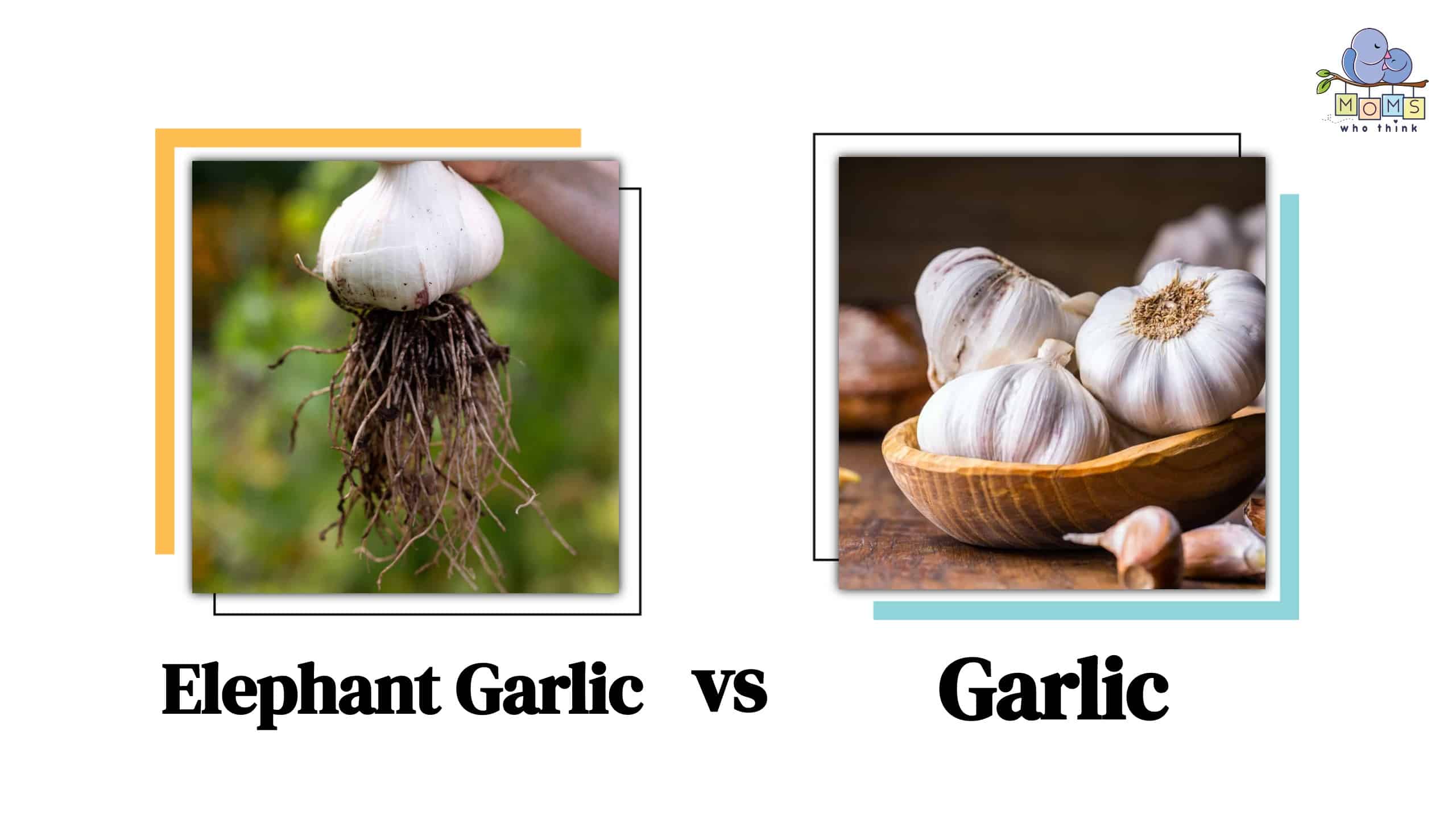Elephant garlic and garlic are both members of the allium genus. However, elephant garlic is classified as leek instead of garlic, making them from the same genus but a different species. So, while they are both called garlic, elephant garlic isn't actually garlic. The main difference between elephant garlic and garlic comes down to size, taste, and color. Elephant garlic is larger and has five or six cloves per head at most, while regular garlic can have close to twenty cloves per head. Regular garlic has a much stronger taste than elephant garlic. And elephant garlic is more off-white or yellow, while regular garlic is white. So, when it comes to elephant garlic vs. garlic, they are not the same.
What is Elephant Garlic?
Elephant garlic is a perennial plant that gets its name because of its large size, usually about twice the size of regular garlic. With such a large size, you might think it has double the garlic taste, but it doesn’t taste like garlic. Instead, the flavor is much closer to an onion or shallot. Elephant garlic plants have flat leaves and sturdy stalks. The flavor isn't as strong as regular garlic and can be eaten raw in salads, roasted, or sauteed, but it is generally not a substitute for conventional garlic in cooking.
Elephant garlic grows in similar conditions to regular garlic. Elephant garlic takes two growing seasons to complete its life cycle, making it a biennial. The plant does not flower in the first year of growth and produces only one bulb. In the second year, the plant will flower and produce multiple bulbs from the divided first bulb. Home gardeners can plant elephant garlic in the Fall or the Spring. A Fall crop takes around eight months to mature, while a Spring crop can mature in three months.
What is Garlic?
Garlic is a flowering plant that has a long history of medicinal and culinary uses. Garlic comes in wide varieties, but they either fall into the hardneck or softneck category. Hardneck garlic is heartier and does better in colder climates, while softneck garlic survives better in warmer climates. There are three types of softneck garlic: silverskin garlic, artichoke garlic, and creole garlic. While the other types of garlic fall under the hardneck category.
Garlic has a strong, pungent flavor that is popular in cuisines all over the world but is probably mostly associated with Italian cuisine. People have been eating garlic for the past 5,000 years, and it's commonly believed to come from Central Asia.
The medicinal use of garlic has a long history of being used as an antiseptic and antibacterial. According to Healthline, ingested garlic can lower blood pressure, boost the immune system, improve cholesterol levels, and detoxify the body. The Cleveland Clinic explains that when used topically, garlic can kill fungi like athlete's foot and even helps clear up acne.
Nutritional Profile

Elephant garlic and garlic have some key differences that set them apart, but they are the same nutritionally. There is no difference in calories or carbs.
How to Use Elephant Garlic
Due to the mild flavor, elephant garlic is not a suitable replacement for garlic. Elephant garlic has a milder taste that is closer to onion than garlic. Home chefs can think of elephant garlic more as a vegetable than a flavor-enhancing herb like regular garlic. Elephanta garlic can be used like shallots or red onion in the salad. Shaving slices and adding raw slices to salads can add some flavor. Roasting elephant garlic makes it soft and buttery, perfect for spreading on toast or crackers. Or add elephant garlic to a stir fry, marinade, dressing, and dip for a slightly onion-like tanginess.
How to Use Garlic
Garlic can be sauteed, roasted, steamed, baked, and raw. The cooking method will determine the intensity of the garlic flavor. Minced fresh garlic is the most pungent, with a strong bite that goes well in marinades and salad dressing. Cooked garlic works well when sauteed with onions, making a great base for soups, pasta sauces, and pizza. Roasted garlic is ideal for dips and spread. When garlic is roasted, the flavor mellows, losing its strong bite.
Garlic has many health benefits, so it's a great addition to a healthy diet. But some diners avoid it due to the smell and the unavoidable garlic breath. But garlic breath doesn't have to ruin your day. You can minimize the dreaded garlic breath by drinking lots of water to flush it out. Of course, brushing and flossing is the best place to start. Then, you can try chewing gum, taking mints, and sipping green tea.
Comparison of Elephant Garlic vs. Garlic

You may think that elephant garlic and garlic are exactly the same. However, there are quite a few dissimilarities between the two. Let's rehash how these two differ:
- Surprisingly, elephant garlic is not actually garlic. In fact, it's actually a leek. On the other hand, garlic is actually garlic.
- Elephant garlic tastes similar to that of onions or shallots, while garlic tastes like garlic, of course.
- A typical garlic bulb has around 20 cloves, whereas elephant garlic has around five or six cloves.
Garlic is a staple in many recipes. If you're looking for a great one to add to your recipe book, check this one out:
PrintGarlic Pork Stir-Fry
- Yield: 4 entrees
Ingredients
1 pork loin (about 8 pounds; do not use tied pork loin roast)
1½ cups soy sauce
½ cup white wine vinegar
2 tablespoons sugar
8 teaspoons minced garlic (about 24 cloves)
1 teaspoon crushed red pepper
4 large onions, cut into 2-inch pieces
4 large green bell peppers, cut into 2-inch pieces
Supplies:
4 one-gallon freezer bags, labeled
12 one-quart freezer bags
On Hand for each entrée:
2 teaspoons vegetable oil
½ cup cornstarch
Instructions
1. Rinse and trim pork loin as desired. Cut pork into bite-size cubes; divide evenly among four or the 1-quart bags. Seal.
2. Whisk together soy sauce, vinegar, and sugar in a medium bowl. Divide the marinade evenly among four 1-quart bags. Into each bag of sauce measure 2 teaspoons garlic and ¼ teaspoon crushed red pepper. Seal.
3. Divide onions and bell peppers evenly among the remaining 1-quart bags. Seal.
4. Into each of the 1-gallon bags, place a bag of pork, a bag of sauce, and a bag of peppers and onions. Seal and freeze.
To Serve:
1. Completely thaw one entrée in the refrigerator.
2. Pour off and discard any accumulated liquid from the bag of pork. Add ½ cup cornstarch; seal bag and shake to coat the meat.
3. Heat oil in a large skillet over medium-high heat. Add pork and stir-fry until thoroughly cooked, about 10 minutes. Add vegetables and sauce. Stir-fry just until vegetables are tender crisp. Serve over your choice of rice.
Notes
Freeze for up to four months.


